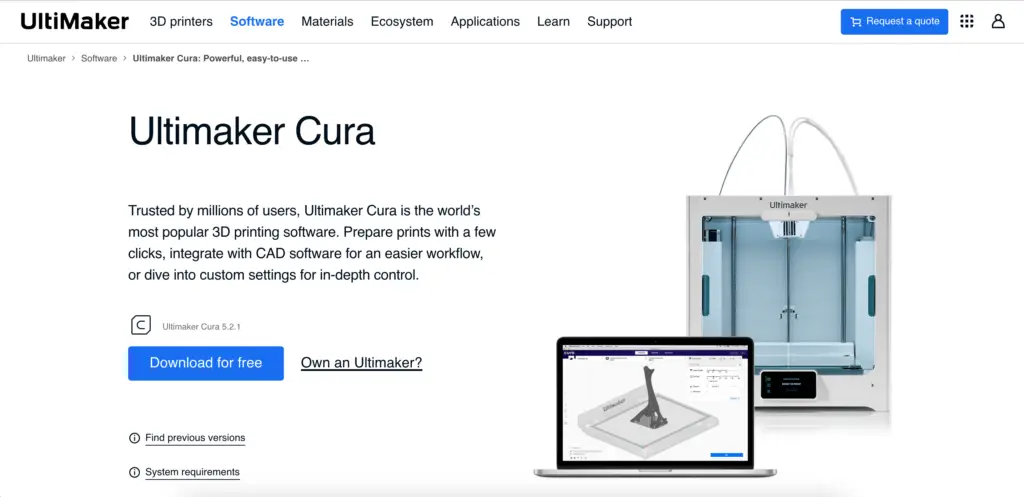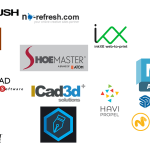Polyethylene is one of the most popular 3D printing materials. Whether you’re a novice or an expert, chances are you’ve used or at least heard of the material.
If it doesn’t ring a bell, it might be because you’re used to its abbreviated names: HDPE and PETG.
The most common types of 3D printing polyethylene are high-density polyethylene (HDPE) and polyethylene terephthalate glycol (PETG), although other polyethylene filaments exist. All of them are highly versatile and ideal for hobby and professional printing as well as making industrial or functional parts.
What Is Polyethylene In 3D Printing?
Polyethylene in 3D printing can refer to any type of filament made of polyethylene material.
Polyethylene filaments can be categorized into four types: high-density polyethylene, low-density polyethylene, polyethylene terephthalate, and polyethylene terephthalate glycol.
The table below compares the various polyethylene filaments*:
| Filament Type | Nozzle Temperature | Bed Temperature | Best For |
|---|---|---|---|
| HDPE | 230°C – 260°C | 100°C – 130°C | Food containers, piping, plumbing components, medical devices |
| LDPE | 115°C – 120°C | 55°C – 65°C | Transparent parts, parts that must resist solvents |
| PET | 235°C – 245°C | 65°C – 70°C | Prototyping, lighting frames, lamp housings, other electronic applications |
| PETG | 220°C – 235°C | 50°C – 70°C | Food and drink containers, toys, machine guards, medical and pharmaceutical devices |
*Nozzle and bed temperature ranges are averages based on manufacturer recommendations. Check your filament’s label for specific printing parameters.
High-Density Polyethylene (HDPE) Filament
HDPE is one of the most popular materials in the world. This is the material today’s plastic water bottles are made of, but it is also used in applications such as piping and house wrap sheeting. Many toys are also made of high-density polyethylene.
The material is versatile, corrosion-resistant, and recyclable – qualities that transformed it into a top contender as far as polyethylene filaments are concerned.
- Our new Filament Printing 101 Course is just for you! Lean how to create perfect professional prints without all the hassle.
- Don't let common mistakes hold you back, click the link to learn more and get ahead now!
You can 3D print HDPE to make functional parts, medical devices, and even food containers – the material is not toxic.
The only downside is that newbies may find it hard to work with it. HDPE is notorious for shrinkage and poor adhesion to common 3D printing build surfaces. For this reason, it is majorly used in industry 3D printing.
Low-Density Polyethylene (LDPE) Filament
Similar to HDPE, LDPE is a popular plastic material commonly used in the production of packaging. However, 3D printing it can be difficult.
The main problem is its susceptibility to both low and high temperatures. Figuring out the right printing parameters can require quite the learning curve, based on your experience, filament quality, and the machine you use.
That said, LDPE filament could be a good choice if you want to print transparent parts. Just keep in mind that LDPE might crack under stress and has high permeability to carbon dioxide and other gases.
Polyethylene Terephthalate (PET) Filament
PET is another polyethylene filament type mostly used for industrial applications.
It is easier to print with than LDPE and HDPE, but the material is prone to stringing, doesn’t like retraction, and becomes brittle easily.
Like other polyethylene types, it is food-safe, stronger than PLA, and virtually odorless (unlike ABS). Yet, it has lost popularity in 3D printing since the introduction of PETG.
Polyethylene Terephthalate Glycol (PETG) Filament
PETG is one of the most popular 3D printing filaments, alongside PLA and ABS. It is used for a variety of applications, ranging from hobby printing to the manufacture of medical, pharmaceutical, and dental parts.
This material is known for its durability and strength. Like other polyethylene types, it can be used to print watertight parts, or parts that must resist UV rays and solvents.
Similar to PET, it is prone to stringing. However, it is more manageable and easier to print with than PET.
PETG’s main downside is its highly hygroscopic nature. It absorbs moisture from the air incredibly fast, which means that it requires proper storage and drying before use.
Pros And Cons Of 3D Printing Polyethylene
Regardless of the type of filament you prefer – or the one that you want to try – all polyethylene materials share some pros and cons. Let’s check them out.
Pros
- Durability & strength: Polyethylene is a versatile material that can resist solvents and UV rays. It has a high tensile strength and is flexible, which makes it perfect for printing a wide variety of prototypes and parts.
- Low weight: HDPE is a lightweight material that provides an excellent strength-to-density ratio. You can use it to print models that must float on water, such as boats.
- Easy to dissolve: Even though polyethylene filaments can resist most solvents, they are all susceptible to limonene. In fact, this solvent can dissolve PE effortlessly, which comes in handy when you want to use polyethylene for printing supports.
- Waterproof material: Even though PE is hygroscopic (it absorbs water/moisture from air), the material is not water-soluble. You can use it for printing watertight containers and other parts that must be waterproof or water-resistant. While the filament will keep absorbing moisture even after printing, this property won’t affect the object’s strength or durability.
- Low cost: All polyethylene filaments are easy to find on the market at affordable prices.
- Sustainable materials: While PE is plastic, the material is fully recyclable. This makes it a good choice for environmentally conscious projects or individuals.
- Food grade material: Polyethylene is not toxic, and the material is approved for food-grade use. This makes it a perfect option for 3D printing food or drink containers, as well as other types of food-safe packaging.
Cons
- Hygroscopic materials: Polyethylene filaments are hygroscopic and absorb moisture from air. To store them properly, you should invest into an airtight filament box. You must also learn how to dry filament before use, or results might be compromised.
- Printing difficulties: Sometimes, these filaments can be challenging to work with. Warping and stringing are often related to PE’s hygroscopic nature. You may also struggle with bed adhesion, and getting the bed and nozzle temperature right could take some time.
- Poor self-adhesion: In addition to printing difficulties, the material is also notorious for its poor self-adhesion and layer separation.
Examples Of HDPE Filament Projects
PETG might be the most popular polyethylene filament, but HDPE could also make a great choice for several project types.
Food Containers
As explained, HDPE is a food-safe and waterproof material that can be used to make all sorts of containers – from water bottles to Tupperware.
Sure, you don’t have to start with full sets of containers, but you could print a missing lid, a bowl, a cup, or anything else you might need around the kitchen.
Piping and Plumbing Components
The exceptional water resistance of HDPE also makes it a choice material in the manufacture of piping and plumbing components.
Aside from actual pipes, you can use HDPE filament to make replacement brackets or valves, smaller sections of pipe, and other plumbing essentials.
Toys
HDPE is a lightweight, strong, and non-toxic material perfect for printing toys.
Not only can you use it for small objects, but HDPE can also be used to make backyard swings and other, larger structures suitable for playgrounds.
Boats
Thanks to HDPE’s low density, you can use this material to print objects that need to maintain buoyancy – such as tiny buoyant prototypes and even full-size boats.
That is because, despite the hygroscopic nature, the material remains waterproof.
Medical Objects
More of an industrial than hobby use, HDPE is also a choice filament for printing medical objects. From medical supplies to invasive devices such as bone replacements, this material can be used for a wide variety of purposes.
The properties that make it perfect for this purpose are the same that make it perfect for toys or food containers – this material is not toxic, it is strong and durable.
Tips For Successful 3D Printing With Polyethylene
Whether you decide to print with HDPE or PETG, these tips should help you complete the project successfully.
Pay Attention to Temperatures
All polyethylene materials require certain temperatures for proper adhesion (including bed and self-adhesion).
For the best results, you should always set the printer within the range specified on your filament’s label, as the material’s composition can slightly vary from brand to brand.
Dry Filament Before Use
As explained, polyethylene is hygroscopic and absorbs moisture from air. From all PETG and PET are the most hygroscopic polyethylene filaments, and they must be dried before use.
LDPE and HDPE are less hygroscopic. You could skip drying, unless their composition contains carbon black. In this case, LDPE and HDPE also need drying.
Use a Printer Enclosure
To prevent soaking the filament with more air moisture as you’re printing, you should consider using a printer enclosure.
The enclosure can also maintain the temperature constant, which is another prerequisite of successful polyethylene printing.
Turn Off Fans
Since polyethylene behaves better when the temperature is constant, you should also turn the fans off.
This can help reduce stringing and warping, as well as other printing defects.
Use Z Offset
Polyethylene can be challenging to print with, the material being stringy and relatively oozy.
Using the Z offset in Cura (or setting it from the G Code) could help you place the nozzle at the right distance from the bed and avoid first layer issues, such as elephant foot defects.
Related Questions
Is PLA the same as polyethylene?
No.
PLA stands for polylactic acid and is a thermoplastic monomer obtained from renewable sources such as sugar cane or corn starch. Polyethylene (PE) is a type of recyclable plastic.
What is the strongest plastic to 3D print with?
The strongest plastic to print with is polycarbonate (PC). This material can be printed with machines that can handle high temperatures.
An enclosed chamber may also be needed to improve results.
Wrapping Up
There are various types of polyethylene filaments you can use in 3D printing. PETG and HDPE are two of the most popular, but PET and LDPE can also serve a variety of applications.
Regardless of the polyethylene type you prefer, all these filaments are durable, resistant, and food-safe. We hope this guide can help you pick the right type for your next project.




